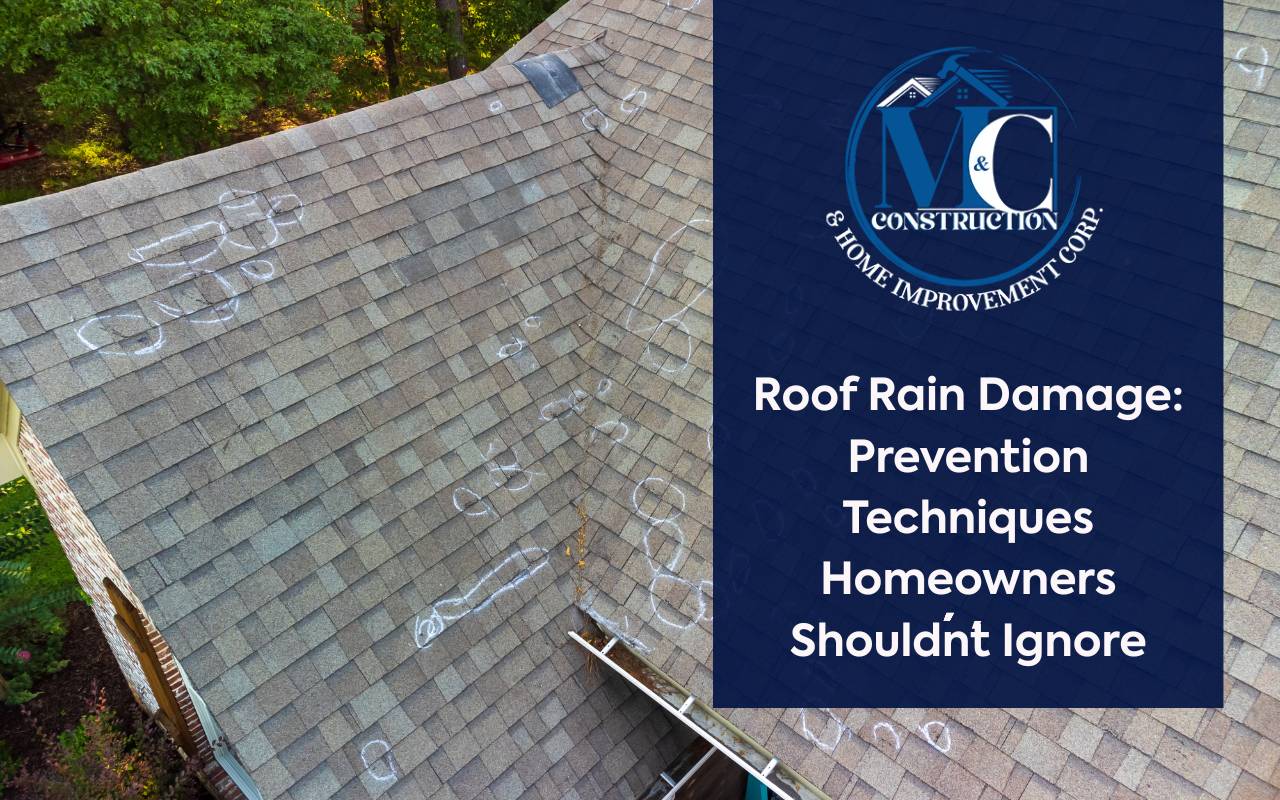Blog
Home / blog

Roof Rain Damage: Prevention Techniques Homeowners Shouldn’t Ignore
When dark clouds gather and raindrops begin to fall, it’s usually a soothing sound. However, this calm can quickly turn stressful when roof rain damage occurs. For homeowners in Ramapo and similar areas, preventive action is essential. Ignoring it can cause expensive repairs, safety risks, and major disruptions. In this guide, you’ll discover proven ways to protect your home from the effects of rain and wind. While many focus on style upgrades, the roof often receives little attention despite being your home’s main protector. Studies show that water damage makes up a large share of home insurance claims, often linked to poor roof maintenance. Regular inspections and upkeep can help you avoid these costly issues and bring peace of mind during every storm.
Importance of Roof Maintenance in Preventing Rain Damage
Consistent maintenance is your best defense against roof rain damage. In storm-prone areas like Ramapo, even minor wear can lead to leaks and mold. Small problems such as cracked shingles or loose flashings may seem harmless but can allow water to enter. Addressing them early prevents bigger, expensive repairs later.
Moreover, a maintained roof enhances energy efficiency and comfort. It keeps air from escaping, easing the strain on your HVAC system. You’ll lower your bills and protect your home from moisture-related health hazards like mold. With a proper maintenance plan, you’ll enjoy a safer, longer-lasting roof and a more comfortable home.
If you prefer expert help, you can easily access Services to explore professional solutions tailored to your roof’s specific needs.
Common Causes of Roof Rain Damage
Deteriorated flashing around chimneys, vents, and skylights lets water in.
Aging or poorly installed shingles curl or crack over time.
Tree limbs and debris damage shingles and trap moisture.
Ice dams block drainage, pushing water under shingles.
Poor attic ventilation and clogged gutters create pooling and structural strain.
Understanding these causes helps you act fast. When you address them promptly, you greatly reduce your risk of roof rain damage.
Signs of Water Damage to Look Out For
Detecting water damage early is vital. Stains or discoloration on ceilings and walls often point to leaks. Peeling paint or bubbling plaster may also signal trapped moisture. Inside your attic, watch for mold, mildew, or damp smells. Daylight shining through boards indicates possible entry points for water. Outside, inspect for missing shingles or sagging areas. Recognizing these signs helps you prevent extensive roof rain damage and protect your investment.
Regular Roof Inspection Checklist
Examine shingles for cracks, curling, or granule loss.
Check flashing around roof openings for rust or gaps.
Clear gutters and downspouts to ensure proper drainage.
Inspect attic insulation for dampness or sagging.
Ensure vents remain open and unobstructed for airflow.
Document small issues immediately. Scheduling timely repairs will prevent larger roof rain damage problems from developing.
Roofing Materials & Their Resistance to Rain Damage
Choosing the right material can make all the difference. Asphalt shingles are popular and affordable but wear down with time. Architectural shingles offer better strength and resist heavy rain. Metal roofs, with interlocking panels, shed water easily and can last over 50 years. Clay or concrete tiles are highly water-resistant but need strong framing. Synthetic options provide durability with less weight. The right material helps your roof handle weather challenges effectively while reducing maintenance needs.
Gutter Maintenance for Rainwater Diversion
Clean gutters in spring and fall to remove debris.
Use gutter guards to reduce clogs and maintenance frequency.
Check slope and attachments for proper alignment.
Extend downspouts at least five feet from the foundation.
By keeping gutters clear, you direct rainwater safely away from your home. This simple step prevents overflow that can cause roof rain damage and foundation problems.
Impact of Proper Attic Ventilation on Preventing Rain Damage
Good attic ventilation reduces moisture and heat buildup. Without airflow, warm air condenses on rafters, leading to rot and mold. Proper venting keeps your roof deck dry and durable. Soffit and ridge vents allow air to circulate, lowering the risk of roof rain damage. Regularly check that vents aren’t blocked by insulation or debris. Balanced ventilation extends roof life and improves home comfort.
Emergency Steps to Take During a Roof Leak
When leaks happen, quick action matters. Place a bucket under the drip to contain water. Move belongings out of harm’s way. If safe, inspect your attic to find the source. Temporarily seal small leaks with roofing tape or caulk. For bigger holes, secure a tarp as a short-term fix. Then, reach out for professional help through Contact to get expert repairs and prevent further roof rain damage.
Professional Roof Repair vs. DIY Solutions
Some repairs, like sealing small cracks or cleaning gutters, can be done safely by homeowners. However, major leaks, structural damage, or full replacements require professionals. Roofing experts bring tools, experience, and warranties that ensure lasting solutions. When storms hit Ramapo, calling certified roofers can save time and money in the long run. It’s the surest way to stop roof rain damage from worsening.
Frequently Asked Questions
How often should I inspect my roof?
Inspect your roof twice a year, ideally in spring and fall. Extra checks after strong storms are also recommended.
What should I do if I notice a small leak?
Contain it immediately and locate the source. Temporary fixes work short-term, but professional repair prevents deeper roof rain damage.
Are metal roofs better against rain damage?
Yes, metal roofs offer excellent water resistance and durability. They also shed rain quickly, preventing pooling and leaks.
Can poor ventilation cause roof problems?
Absolutely. Inadequate ventilation traps heat and moisture, which can weaken roofing materials and cause mold growth.
Should I clean gutters even if I have guards?
Yes, inspect them twice a year. Gutter guards reduce buildup but don’t eliminate the need for routine cleaning.
Safeguarding Your Home Against Roof Rain Damage
Preventive care ensures long-term protection for your home. By identifying weak points, inspecting often, and keeping your roof clean, you can prevent costly roof rain damage. Whether you do it yourself or hire experts, consistency is key. Stay proactive and ensure your roof continues to protect your family from every storm that comes your way.
Free estimates available
@ 2025 - M & C Construction & Home Improvement Corp. | All Rights Reserved


